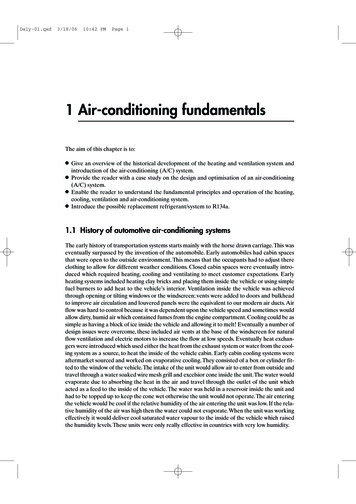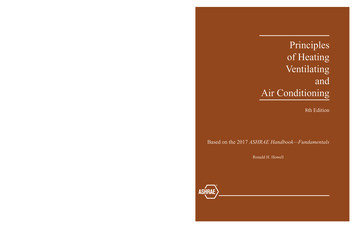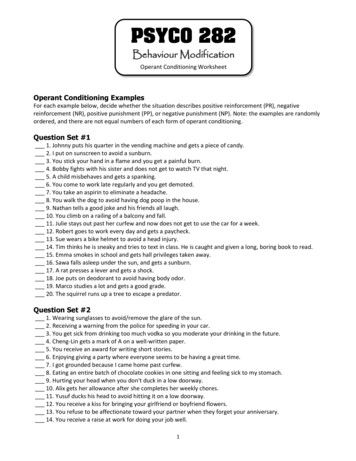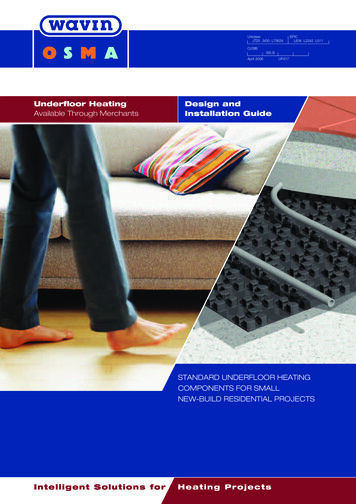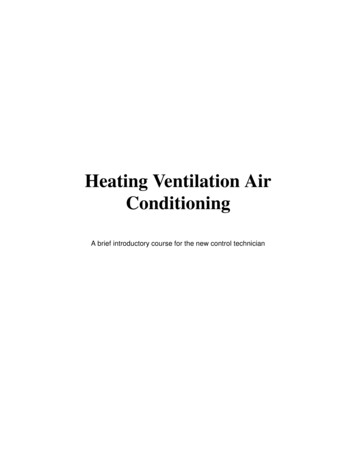
Transcription
Heating Ventilation AirConditioningA brief introductory course for the new control technician
Understanding HVAC Fundamentals1.1 HVAC System Functions 5HVAC System Types and Applications 71.2 Designing the HVAC System 11HVAC Design Factors 11Cooling and Heating Loads 13Installing the HVAC System 141.3 Comfort 17Comfort 17Heat 17Humidity 18Ventilation 191.4 HVAC System Components 21Air Conditioning Theory 21HVAC System Components 211.5 HVAC System Control Components 27Automatic Control Systems 27Automatic Control System Components 27Automatic Control System Classification 29Exploring the Physical Sciences2.1 Units 35English and SI Units 35Unit Conversion 362.2 Temperature 39Absolute Zero 39 F to C Conversion 392.3 Force 41Force Characteristics 412.4 Pressure 45Types of Pressure 45Pressure Measuring Instruments 472.5 Energy 51Forms of Energy 512.6 First Law of Thermodynamics 552.7 Solids, Liquids, and Vapors 57Kinetic Molecular Theory 58Boiling Point Conditions 59Refrigeration 60-2Lesson 1-
Differentiating Heating and Cooling Loads3.1 Heat Transfer Principles 67Methods of Heat Transfer 67Thermal Resistance 693.2 Heating Load 753.3 Cooling Load 79Understanding Psychrometrics4.14.24.34.4What is Psychrometrics? 85Physical Properties of Air 89The Psychrometric Chart 93Process Lines 101Sensible Heat Ratio 104Apparatus Dew Point 105Coil Contact and Bypass Factors 106Examining Fluid Flow5.1 Fluid flow continuity equation 1115.2 Flow energy equation 115Energy balance principle 1155.3 Pressure in fluid systems 119Velocity pressure 120Static Pressure 120Total Pressure 1205.4 Pressure loss in fluid systems 123Pressure loss in piping systems 123Pressure loss in duct systems 125Analyzing Pumps and Piping Systems6.1 Pump characteristics 131Pump selection 1376.2 Hydronic Piping systems 139Piping system classification 140Piping system arrangements 1416.3 Expansion and compression tanks 151Lesson - 1-1
Expansion tanks 151Compression tanks 152Piping system pressure 1536.4 Air venting 157Air venting devices 1576.5 Valves 161Valve Construction 161Valve Flow Characteristics 162Valve Flow Terms 164Valve Ratings 165Valve Types 166Analyzing Heat Generating Systems7.1 Boilers 175Boiler Use Advantages 175Boiler Components 176Boiler Operation 178Boiler Classification 179Boiler Arrangements 179Boiler Capacity Ratings 180Boiler Controls 1807.2 Warm Air Furnaces 183Furnace Components 183Furnace Operation 185Furnace Classification 186Furnace Construction 186Furnace Capacity and Efficiency Ratings 188Furnace Controls 189Analyzing Cooling Systems8.1 Cooling systems 193Thermodynamics of Refrigeration 193Refrigeration System Capacity 1938.2 Vapor Compression Refrigeration 195Vapor Compression Equipment 1978.3 Cooling System Components 199Evaporators 200Flow Control Devices 202Compressors 2030Lesson 1-
8.4 Absorption Refrigeration 213Absorption Refrigeration Components 215Absorption Refrigeration Operation 2168.5 Cooling Towers 221Cooling Tower Equipment 221Cooling Tower Operation 223Types of Cooling Towers 2258.6 Refrigerants 229Refrigerant Types 231Compression Type Refrigerants 232Absorption Type Refrigerants 232Recognizing Air Distribution Systems9.1 Fan systems 237Fan types 237Fan selection and installation 2429.2 Fan laws 2459.3 Air delivery systems 2499.4 Air delivery system equipment 253Air handling units 253Humidifiers 258Dehumidifiers 261Filters 262Air distribution requirements 264Identifying Terminal Units10.1 Hydronic terminal units 271Heating hydronic units 271Cooling hydronic units 27510.2 Air delivery terminal units 279Constant Air Volume 279Variable Air Volume 279VAV types 280VAV disadvantages 28310.3 Heat pump terminal units 287Heat pump operation 289Lesson - 11
2Lesson 1-
1Understanding HVAC FundamentalsExplore the purpose and components of HVACsystems. HVAC System Functions Designing The HVAC System Comfort HVAC System Components HVAC System ControlComponents
4Lesson 1-
1.1 HVAC System FunctionsThe need to control indoor environmental conditions has given rise to many innovations and technologies. Heating, Ventilation, and Air Conditioning (HVAC)technology has advanced rapidly in the last 100 years. HVAC systems do morethan simply cooling air; they maintain comfort by controlling temperature, humidity, air cleanliness, air distribution and pressure. The amount of CO2 in a controlled space is now often monitored as an indication of occupancy and the needfor more ventilation air.HVAC systems maintain indoor environmental conditions or sometimes therequired conditions for process control. People are most comfortable and productive if their environment can be maintained within narrow temperature, humidityand air quality ranges. For example, one of the first applications of modern airconditioning was in early movie theatres. During the summer attendance was verylimited because a room filled with hundreds of people would quickly become veryhot and humid. When the theatre marque proudly advertised that it was cooledinside people would pay just to be cool for awhile. This was also a boon to themovie industry.Photo courtesy of Gordon McAlpinLesson - 15
New TermsAir ConditioningThe process of maintaining anindoor environment by controlling temperature,humidity, air quality, distribution, cleanliness, andair pressure.CO2 The trace gas used to monitor occupancy ina zone.HVAC system The equipment, ducting and pipingused to control the environment in a zone is called aheating, ventilation, air conditioning system. .HumidityAir qualityThe amount of moisture present in air.The degree of air purity.To meet the varied needs for maintaining these indoor environmental conditions,HVAC systems may need to cool or heat, humidify or dehumidify, ventilate, filter,distribute, or pressurize air.Cool/heat- HVAC systems control the temperature in an indoor environment as thesystem transfers heat to or from a particular zone, that is, the room or space beingmaintained by the HVAC system. If a building is cold, a heating device (heat generation system) is required to transfer heat into that space and replace the heat lostto the outside. When a building is hot, a cooling device is required to remove theexcess heat to the outside.Humidify/dehumidify- HVAC systems control the degree of moisture present inthe air. Humidifying (adding moisture to) the air may be necessary in wintermonths or in a dry climate. Dehumidifying (removing moisture from) the air ismore often required in summer months and humid climates.Ventilate- HVAC systems control the air quality of the buildings zone by ventilating the space with fresh air from outside the building. Air is polluted by occupantsand by the off-gassing of interior carpet, paint, and other furnishings. Outside air isadded into the buildings zone to dilute the interior air, and some of the polluted airis exhausted to the outside of the building.Filter- HVAC systems pass outside air through a filter to remove unwanted partic-6Lesson 1-
ulates. We can typically allow some amount of recycled air to re-circulate backinto the building, this recycled air is also filtered for particulates before re-enteringthe building zone.Distribute- HVAC systems distribute conditioned air or heating/cooling waterthroughout the building. Air is distributed through ducts and water is distributedthrough a piping system.Pressurize- HVAC systems control the infiltration of unfiltered, unconditioned airby bringing more outside air in than is exhausted. This situation provides a slightlyhigher pressure inside the building than outside, limiting the movement of outsideair through doors, walls, cracks, and windows. Pressurization is also needed tomove conditioned air through a building.Depending on the situation, an HVAC system may need to perform cooling anddehumidifying at certain times of the year and then perform heating and humidifying at other times and ventilation, distribution, filtering and pressurization all ofthe year. These HVAC system functions enable the system to control variables inan indoor environment that determine if a building zone is comfortable or not.Occupants feel comfortable if the air and surface temperatures are not too warm ortoo cold, if the percentage of moisture present in the air does not feel clammy ordry, and if the distribution of particle-free air is not drafty.HVAC System Types and ApplicationsTo meet occupant needs, HVAC systems are varied. There is great flexibilityin the types of HVAC systems that are used as well as the design ofcomponents that constitute these systems. One way to categorize HVACsystems is by the method used to move heat. The two choices are wet systemsor dry systems. They are shown in Table 1.0:Table 1.1 HVAC System TypesLesson - 1HVAC system typesApplicationSystem componentswet systemsApartment buildingsSchools,Commercial buildingsIndustrial buildingsResidencesBoiler, chillerPipingCoil or RadiationdevicePumpdry systemsSchools,Commercial buildingsIndustrial buildingsResidencesFurnace and A/CDuctsAir outlet registersHumidifier7
Wet systems consist of a boiler and/or chiller, piping, coils or radiationdevices, and pump(s). Heat can be economically moved into or out of abuilding by circulating water through the appropriate devices. Wet systemsusually mean there is a central plant in the building with chillers and/orboilers and supporting equipment.Dry systems can consist of a furnace or air handler, A/C coil and condensingunit, ductwork, air outlet registers or diffusers, and sometimes a humidifier.This type of HVAC system is common in residences and many commercialbuildings. Heat is added to or removed from the air supplied to the buildingszones. Dehumidification and humidification can be provided for occupantcomfort.New Termwet systems HVAC systems that use circulating water orsteam to add or remove heat from a building.dry systems HVAC systems that use air flow to add orremove heat from a building.ReviewHVAC systems are technologically advanced air conditioning systemsdesigned to maintain comfort levels in indoor environments. Environmentalconditions vary, so a typical HVAC system will serve differing conditionsthroughout a typical day or season.Space temperature, humidity, air distribution, and air cleanliness are allvariables that the HVAC system regulates. Wet systems and Dry systems arethe two main types of HVAC systems.Wet systems pipe water through a building to move heat into or out of theinterior spaces. Dry systems direct air through a building to move heat into orout of the interior spaces.8Lesson 1-
Exercises: 1.11.What is air conditioning?2. What are the two main types of HVAC systems?3. List six HVAC system functions.Lesson - 19
10Lesson 1-
1.2 Designing the HVAC SystemFactors that influence comfort must be considered in HVAC system design.These factors can be divided into two categories: internal and external.HVAC Design FactorsInternal factors are possible sources of heat from inside a building. Possibleinternal factors typically include people, lights, computers, copy machines,coffee makers, production equipment, and any other machinery that puts offheat. Each watt of electricity used in a space gives off 3.14 BTUs/HR of heat.We’ll learn what a BTU is later.External factors are possible sources of heat from outside a building. Possibleexternal factors include wind, solar radiation, transmission of heat throughthe structure of the facility, and the leakage of heat out of or into the buildingthrough walls due to temperature differences, windows, cracks, and doors dueto infiltration.Lesson - 111
New Termsinternal factors Sources of heat generation from within abuilding, including people, lights, and machinery.external factors Sources of heat generation from outside afacility, including wind, solar radiation, transmission, andleakage.Solar radiation is the heat generated and released by the sun aselectromagnetic waves. This heat is greater in the east in the morning andwest in the afternoon. The sun’s radiation can penetrate glass, and can be usedas a heat source to warm interior space.Transmission is the heat transfer process of moving heat through walls andwindows into or out of a facility. Different materials transfer heat at differentrates. When the outside temperature is above the inside temperature, heattransfers into the facility through the outside structure. When the outsidetemperature is lower than the inside temperature, heat will be transferred outof the building. This is why offices and rooms in a house can become so warmin the summer and so cold in the winter.Leakage occurs when pressure differences in a building cause air to infiltrateor exfiltrate through cracks in walls, doors, windows, and roof equipmentpenetrations.New Termssolar radiation The heat generated by the sun. Energyemitted from a source in the form of rays.transmission The heat transfer process of moving heatthrough walls and windows into or out of a facility.leakage The escaping of heat through cracks in walls,windows, doors, or any other opening in the structure of afacility.12Lesson 1-
Cooling and Heating LoadsCooling load is the total heat gained from the sum of internal and externalfactors. This heat must be removed by cooling the zone or building. Abuilding may have different cooling load ratings for different zones within itbecause of different internal and external factors in any area at any giventime.Heating load is the total heat lost from the sum of internal and externalfactors. This heat must be replaced by adding heat back to the various areas inthe facility that are cooler than the desired setpoint.Lesson - 113
New Termscooling load The total heat gained from internal andexternal factors.heating loadfactors.The total heat lost from internal and externalsetpoint The desired temperature that is monitored by athermostat or other type of sensor.Installing the HVAC SystemThe general contractor is responsible for the completed construction of abuilding. For large-scale building projects, the general contractor hiressubcontractors to help complete the project. The general contractor hires amechanical or HVAC contractor to professionally install the HVAC system.The HVAC contractor works with a consulting mechanical engineer todesign the HVAC system. The mechanical engineer creates the contract orengineering drawings of the HVAC system for a building depending on theneeds of the owner, the facility’s function, the comfort factors, and theinternal and external design factors. The HVAC contractor takes theengineering drawings and creates shop drawings to be used as guidelines forthe workers installing the HVAC system. The HVAC contractor hires workersto install the HVAC system and procures equipment.After the HVAC system is installed, the Balancing contractor is responsiblefor testing, adjusting, and balancing (TAB) the HVAC system to verify thatthe system operates correctly.14Lesson 1-
New TermsHVAC contractor Also known as the mechanicalcontractor, responsible for the installation of the HVACsystem.consulting mechanical engineer Engineer responsible fordesigning the plans and specifications for installation of anew HVAC system.engineering drawings The plans and specifications for theinstallation of a new HVAC system.shop drawings The HVAC contractor’s larger-scaled, andmore detailed, plans and specifications that are given to theworkers to use as instructions for the installation of an HVACsystem.ReviewDesign is important to the successful operation of an HVAC system. Theoccupants’ needs will be met if the designer considers both internal andexternal factors.People, lights, and equipment are internal factors that affect the temperature,humidity, and air quality in a facility.Wind, solar radiation, transmission, and leakage are all external factors thataffect the temperature, humidity, and air quality in a facility.Internal and external factors cause a facility to lose or gain heat. The totalheat gained is the cooling load, and the total heat lost is the heating load.The HVAC contractor is responsible for the installation of the HVAC system.A consulting mechanical engineer designs the HVAC specifications and theHVAC contractor creates shop drawings from the specifications that theworkers use as installation instructions.Lesson - 115
Exercises: 1.21. Identify the following HVAC design factors as Internal or External bycircling the correct factor ternalExternalSolar nternalExternal2.Fill in the blanks below with the correct word(s) to make the followingstatements true.The is the total heat lostfrom internal and external factors.The is the total heatgained from internal and external factors.The is responsible forcreating the engineering drawings.The is responsible forcreating the shop drawings.3. Describe a setpoint.16Lesson 1-
1.3 ComfortComfortComfort is a subjective feeling. Because individuals perceive comfortdifferently, comfort cannot be measured directly. Variables that affect aperson’s comfort are indoor air quality and body heat loss. While anindividual person’s comfort level encompasses many complex factors, HVACsystems function primarily to maintain thermal comfort.Thermal comfort will exist when someone is surrounded by an environment ofproper temperature, relative humidity, air quality and distribution that allowsthem to give up their body heat at the same rate it is produced. A person’sbody generates heat as it performs routine bodily functions such as theoxidation of food substances or body fat. As the body is producing heat, itwill also be losing it through the process’ of radiation, conduction orconvection. The average temperature of the human body depends upon abalance between the sum of the heat generated by the body and the sum of theheat loss to the surrounding air.New Termsradiation The process of heat being given off from the bodyin electromagnetic ray form as it produces heat from internalchemical reactions or body processes.conduction The process of heat being transferred bymolecule to molecule through direct contact.convection The process of heat being transferred by a fluid.HeatHeat is a form of energy that can exist on its own and can be moved from onelocation to another. Heat is not matter; it does not exist as a solid, a liquid, orgas, and so it cannot be measured by weight or volume. When we think ofheat, we tend to think of temperature, but temperature does not really measureheat content. Instead, temperature indicates the average velocity of theLesson - 117
molecules of a substance, or the intensity of heat in a substance. As thetemperature of heat in a substance increases, the molecules move morerapidly. As the temperature drops, the molecules slow down. If all heat isremoved from a substance all molecular motion stops. This is called absolutezero.Temperature is generally measured in degree Fahrenheit ( F) or degreeCelsius ( C) units. For example, water at sea level has a freezing point of32 F or 0 C, and a boiling point of 212 F or 100 C. Fahrenheit is the mostcommonly used temperature scale in the United States. It is used in theremainder of this training workbook.Heat content is most frequently measured in British Thermal Units or BTUs.A BTU is the amount of heat required to raise the temperature of one pound ofwater by one degree Fahrenheit. For comparison purposes, the completeburning of a common wooden match produces approximately one BTU.The rate of heating is generally described in terms of BTUs per hour, BTU/h.This expression describes not only how much heat is present but also how fastthe heat energy is transferring.New Termstemperaturesubstance.The average molecular velocity of aBritish Thermal Units (BTU) The amount of heat requiredto raise the temperature of one pound of water one degreeFahrenheit. BTU/h is the rate of heat transfer.HumidityHVAC systems monitor and control the variables in an indoor environmentthat affect the occupants’ perceptions of thermal comfort. Temperature andhumidity impact the skins evaporation rate. If the evaporation rate to thesurrounding air is too high or too low, the body will feel uncomfortable. If theair is dry, the evaporation rate increases, so heat transfers from the body at ahigher rate. This may cause the person to feel chilly even when airtemperature is in the mid 70s.Space temperature is the temperature of the air in a building zone18Lesson 1-
Humidity slows down the evaporation process. High temperature andhumidity cause the body mechanism to work harder to disperse heat, and thebody feels uncomfortable.Relative humidity is the ratio of the amount of water vapor actually presentin the air to the greatest amount possible at the same temperature.New Termsspace temperature The actual measured temperature of theair in a space or zone under control.relative humidity The percentage of the amount of watervapor present in the air compared to the maximum the aircould possibly hold.VentilationCleanliness/ventilation relates directly to comfort. Ventilating fresh outdoorair into a facility replaces polluted air from occupants and interiorfurnishings. In most cases, outdoor air is fresher than indoor air.Contaminants such as dust and smoke can be physically removed through theHVAC system. Proper HVAC filtering and ventilation can reduce particlespresent in indoor air that irritate the eyes, nose, and lungs.ReviewComfort is not only affected by combinations of temperature, humidity, andair distribution, but also by physical activity. Comfort levels vary in as manyways as people do.Lower relative humidity levels require a higher temperature to maintaincomfort. Conversely, higher relative humidity levels require a lowertemperature to maintain comfort.Lesson - 119
Exercises: 1.31.Identify three conditions that affect the rate of body heat loss.2.Which of these conditions can be controlled by an HVAC system?3.How are these conditions adjusted to improve human comfort?20Lesson 1-
1.4 HVAC System ComponentsAir Conditioning TheoryHVAC system components transfer heat from one place to another to moveand condition indoor air. The Second Law of Thermodynamics states that heattransfers in one direction from a higher temperature source to a lowertemperature source. HVAC systems function on this principle to either addheat to or remove heat from a facility to control and maintain comfort.HVAC System ComponentsA facility’s HVAC system can consist of different parts depending on what thepurpose of the facility dictates. For example, if a facility requires the indoorspace in the basement to be cooled, the HVAC system needs to include heatrejecting equipment. Simultaneously, if the facility requires the remainingfloors to be heated and cooled, the HVAC system must not only include acooling source but a heating source as well. The mechanical componentstogether perform all functions required in a facility’s HVAC system beyondjust temperature control. HVAC system design requirements may includeheating, cooling, ventilating, humidifying, dehumidifying, pressurizing, andthe distributing of air or water.New Termheat-rejecting Equipment that removes heat from aspecified area in order to cool the temperature of that space.Lesson - 121
Table 1.2 HVAC System ComponentsTypical HVAC system componentsExampleHeat generation systemBoilerFurnaceElectric heating coilHeat rejection systemChillerWindow air unitEvaporative spray coilAir delivery systemFanSheet metal ductTerminal unitFanFilterDampersMixing boxPiping systemCoilHeat generation systems are major HVAC system components involved inmaintaining human comfort. The heat generation system is the primary sourceof heat energy for a facility. Its purpose is to transfer heat to the areas in afacility that are cooler than desired. Examples of heat generating componentsare boilers, electric heating coils, and gas-fired furnaces.Drawing courtesy of Cleaver Brooks22Lesson 1-
Heat rejection systems, or the cooling system, is another major HVAC systemcomponent involved in maintaining comfort. It transfers heat from where it istoo warm to an area where it is needed or not objectionable. Examples of heatrejection components are a chiller, a window A/C unit, and an evaporativespray coil.Drawing courtesy of The Internet Encyclopedia of ScienceAir delivery systems provide the means for transferring heated and chilled airthroughout a facility. Air delivery systems typically combine outside andrecycled building air, filter it, add or remove heat from it, and often timeshumidify or dehumidify it before transferring the air throughout the facility.This system usually consists of a fan that blows air through sheet metal ducts.The ductwork is like an artery that supplies air to all the rooms in a facility.Lesson - 123
Terminal units are the last piece of equipment involved in the delivery offresh air to a facility. After the heated or cooled air passes through the airdelivery system, it disperses through the terminal units. Terminal units areusually located in the spaces they condition. Examples of terminal units areunit ventilators, fan coils, VAV boxes.Pumping systems force a fluid, usually water, through a piping system. Thefluid is the control agent that transfers energy from primary energy sources,such as heat generating systems or cooling systems, to air delivery systemsand/or terminal units. The heat energy transfers from the control agent to theair through a coil. A coil is an arrangement of tubes with heat transfer finslocated in the air stream. Hot water coils release heat into the air in a heatingsystem. Chilled water coils absorb heat in a cooling system. A car radiator is acommon example of a heat transfer coil.24Lesson 1-
New Termfluid A substance such as a liquid, gas, or steam that cantake on the shape of its container.ReviewHeat always travels from a warmer object to a cooler object. HVAC systemsprovide the means to transfer heat.An HVAC system consists of different system components that give it theability to function as it is designed to maintain comfort.A typical HVAC system consists of a heat generating device, a cooling systemdevice, ducts to transfer the conditioned air, pipes to transfer heat through afluid, and terminal units that disperse conditioned air into the spaces where itis needed.Lesson - 125
Exercises: 1.41. Whatis the Second Law of Thermodynamics?2.What are the basic system components of a typical HVAC system?3. Match the letter of the correct HVAC system component to itscorresponding function description.Function Description26AnswerHVAC System ComponentPrimary source for heat energy.A. Air delivery systemEnables the transfer of heated and cooled air.B. Heat rejection systemSmall version of an air delivery system.C. Pumping systemPrimary source for cooling energy.D. Heat generation systemEnables the transfer of heat through a fluid.E. Terminal unitLesson 1-
1.5 HVAC System ControlComponentsAn HVAC system’s automatic controls are vital to the overall functionality ofthe system. The control components regulate a facility’s HVAC system so thatit maintains desired comfort levels, conserves energy, reduces labor costs, andmaintains safe equipment operating conditions.Automatic Control SystemsAutomatic controls regulate environmental conditions of the control zone toensure that the HVAC system maintains comfort. When the system detects thetemperature is too hot or too cold, meaning the load in the space has changed,the controls activate the HVAC system to add or remove heat from thebuilding to maintain comfortable conditions.New Termsload Heat that is lost or gained.Energy is conserved when the controls maintain interior conditions withinpredetermined limits. The HVAC system can reset setpoints based on outsidetemperatures in anticipation of load changes, allow the use of outside air tocool inside the building to conserve energy and employ other energyconservation strategies.The automatic controls also keep HVAC system equipment operating safely.If the equipment is allowed to operate unsupervised, serious damage canoccur. For example, boilers and chillers must have the proper supportequipment operating before they are enabled.Automatic Control System ComponentsControl system components work together to gather data about facilityconditions, measure it, and transfer energy from one location to anotherthrough the HVAC system. The three main elements of a control system are aLesson - 127
sensor, a controller and controlled device. Two additional elements that arealways assumed present in the control system are the controlled medium andcontrol agent.Table 1.3 Control System ElementsControl system elementsDescriptionSensorMeasures a controlled variable (temp,press, etc.)ControllerCompares the setpoint to control point andadjusts the controlled deviceControlled deviceRegulates the flow of the control agent(valve, damper, etc.)Controlled mediumFluid that transfers the energy to or fromthe process or zone (air in the air handler)Control agentTransfers the required energy to or fromthe controlled medium (steam in theheating coil)All three basic components of an HVAC control system are necessary to makeautomatic control of the system possible. The sensor measures a controlledvariable such as temperature or pressure or level. The sensor then transmitsthat information to the controller. The controller compares the measuredcontrol point against the desired setpoint and generates an output to bring thetwo closer together. The controlled device regulates the amount of controlagent to the desired amount.28Lesson 1-
Automatic Control System ClassificationAutomatic control systems can be class
Understanding HVAC Fundamentals 1.1 HVAC System Functions 5 HVAC System Types and Applications 7 1.2 Designing the HVAC System 11 HVAC Design Factors 11 Cooling and Heating Loads 13 Installing the HVAC System 14 1.3 Comfort 17 Comfort 17 Heat 17 Humidity 18 Ventilation 19 1.4 HVAC System Components 21 Ai

